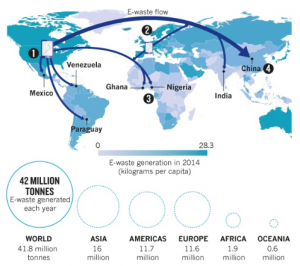Bottled water is drinking water (e.g., well water, distilled water, mineral water, or spring water) packaged in plastic or glass water bottles. Bottled water may be carbonated or not. Sizes range from small single serving bottles to large carboys for water coolers.
Chapter 17 explores the rise of the bottled water industry over the last few decades in terms of its causes and consequences. The risk perception and political economy approaches are used to explain how bottled water use and its environmental consequences vary by location and level of affluence.
Bottled Water slides here.
Paul Robbins, John Hintz, and Sarah A. Moore, Environment & Society: A Critical Introduction (3rd edition), Chapter 17.
Notes & Links:
All about the water from our campus sulfur spring, part of the mid-19th-century commodification of spring water in the US. Recall that what is now Elliott Hall was built as the Mansion House Hotel, adjacent to the sulfur spring. I have not been able to find out if water from the spring was ever bottled and sold, but it was consumed by hotel guests.
The Ohio Medical and Surgical Journal …, Volume 9; Volume 11, 1857
DELAWARE SPRINGS.
The result of the analysis of the “Sulphur Springs,” at Delaware Ohio, made by Prof.H. Mitchel, of Kenyon College, as published by the proprietor of the springs, is as follows:
One hundred grains of the deposit obtained by evaporating several gallons of water, contained,
48 grams: Muriate of Soda, (common salt)
20 grams: Muriate of Lime
16 grams: Sulphate of Magnesia,(Epsom salts)
08 grams: Sulphate of Lime
05 grams: Carbonate of Lime
03 grams: Loss
Solid contents = 100 gramsAnd one wine pint contained,
Sulphuretted Hydrogen Gas, 12 cubic inches
Carbonic Acid Gas 3 cubic inchesThis water, [Delaware,] it seems owes its active medicinal virtues chiefly to the very large quantities of Muriate of Soda, and Sulphate of Magnesia it contains; and no better means of relief can be afforded in diseases dependent upon plethora, with its various manifestations, than the judicious use of mineral waters of this class, which promote copious secretions from the bowels without irritation, and not only afford relief, as purgatives, but they act as deobstruents and alteratives, and are supposed by some, to imitate very closely, the critical evacuations that sometimes occur in the progress of disease relieving congestion of the mucous membranes, the liver, etc., without occasioning the commotion incident to the use of drastic purgatives.
The well-known celebrity that the water of these springs has acquired, since Prof. Mitchell’s analysis, is ample proof of its efficacy as a remedial agent.
- Animated Map Shows Where Your Bottled Water Actually Comes From (YouTube Video)
- National Water Information System: Mapper (interactive web map)
- Find a Spring (world-wide collection of springs)
- Carbon Footprint of Bottled Water (article)
- Map My Water: drinking water, water quality, water quantity, contaminiation (web maps and information)
- “Desalination Is Booming. But What About All That Toxic Brine?” (Wired article)
- Drinking Water Advisories for Ohio Public Water Systems (Ohio Environmental Protection Agency)
- PFAS Contamination in the U.S. (map; what are PFAS?)
- EWG’s Tap Water Database (search by zip code, for US)
- Search “chemicals in bottled water” (Google)
- *(ok, panic)*
- “Private Companies Pump Cash from Troubled Municipal Drinking Water Systems” (article)
- YOU (students) are the target of soft drink companies (bottled water and other beverages): “The biggest college rivalry in America: Coke versus Pepsi“
French fries, or simply fries, chips, finger chips or french-fried potatoes, are batonnet or allumette-cut deep-fried potatoes.
Chapter 18 takes the French fry as its object of concern and views the health and environmental concerns associated with its consumption. Specifically, this chapter views French fries through the risk and hazards, political economy, and ethics perspectives.
French Fry slides here.
Paul Robbins, John Hintz, and Sarah A. Moore, Environment & Society: A Critical Introduction (3rd edition), Chapter 18.
Notes & Links:
- Wild Potatoes (Solanum section Petota): overview and varieties
- Wild Potato Atlas (interactive map)
- Atlas of Wild Potatoes (downloadable PDF)
- International Potato Center (organization)
- Notes of a Potato Watcher (book)
- The Daily Spud (blog)
- Carbon Footprint of Food (Potato is the worst vegetable)
- “How Fast Food Advertisements Get Under Your Skin, Whether You Realize It Or Not“ (article)
- Super Size Me (documentary)
- Super Size Me 2: Holy Chicken! (documentary). Includes prank Holy Chicken restaurant opened in Columbus. And Spurlock’s an asshole.
- “How Fast Food Chains Supersized Inequality: Fast food did not just find its way to low-income neighborhoods. It was brought there by the federal government.“ (article)
- “Do minority and poor neighborhoods have higher access to fast food restaurants in the United States?“ (article)
- “Pepsi withdraws Indian potato farmer lawsuits after political pressure“ (gentically modified and patented potato variety grown for potato chips and other snacks). Patent on the FL 2027 (FC05) potato is here.
- “Photo Gallery of Vegetable Problems – Potato” (gallery)
formerly beloved E-junk everwhere.
Chapter 18 takes electronic waste, or e-waste, as its object of concern. E-waste presents a difficult puzzle because poor and marginalized communities suffer the health and environmental consequences of e-waste rather than the wealthier consumers of electronic devices, yet many do benefit from the treatment of e-waste as a tradable commodity or resource for raw materials. E-waste is thus viewed in this chapter from the Risk and Hazards (Chapter 6), Markets and Commodities (Chapter 3), and Political Economy (Chapter 7) perspectives.
E-Waste slides here.
A New Generation of Students Is Teaching Us How to Reduce E-Waste
In colleges and universities across the United States, students are taking classes on how to repair our electronics that normally end up as e-waste.
Paul Robbins, John Hintz, and Sarah A. Moore, Environment & Society: A Critical Introduction (3rd edition), Chapter 19.
Notes & Links:
 Agbogbloshie, Ghana (source)
Agbogbloshie, Ghana (source)
 eWaste World Wide Trade & Movement
eWaste World Wide Trade & Movement
- Waste Electrical & Electronic Equipment (WEEE) (European Community)
- What a Waste 2.0: A Global Snapshot of Solid Waste Management to 2050 (World Bank report)
- e-Waste Substances – hazardous and nonhazardous (Wikipedia)
- Collecting Batteries (hobby)
- Retrocomputing (collecting and using old computers)
- RenTech: Electronics refurbishing and recycling employing adults with developmental disabilities
- Delaware (Ohio) area electronics recylcing options (PDF)
- Basel Convention (primary web page)
- “Electronics recyclers plead guilty to fraud” (article)
- Fake Electronics Recycling (website)
- “A Shocking Amount of E-Waste Recycling Is a Complete Sham” (tracking ewaste with GPS, Vice)

